Rasam Recipe (Without Rasam Powder & Lentils)
Rasam is a tangy, spiced, herby and soupy preparation from the South Indian cuisine, made with tamarind, tomatoes, and a medley of spices, then tempered with mustard seeds, curry leaves, and dried red chilies. It is commonly served with steamed rice or enjoyed as a warm broth. My quick Rasam recipe is made without rasam powder and lentils (dal). This spiced, tangy, and sour rasam is sure to warm your palate and heal your cold if you have any.
About Rasam Recipe
Rasam is a staple in many South Indian households and has a base of various herbs, spices, lentils, veggies/fruits and tamarind. Yes, you heard me right – rasam is made with some fruits too.
Probably the word “rasam” is derived from the word “ras” or “rasa” which means juice or extract or essence.
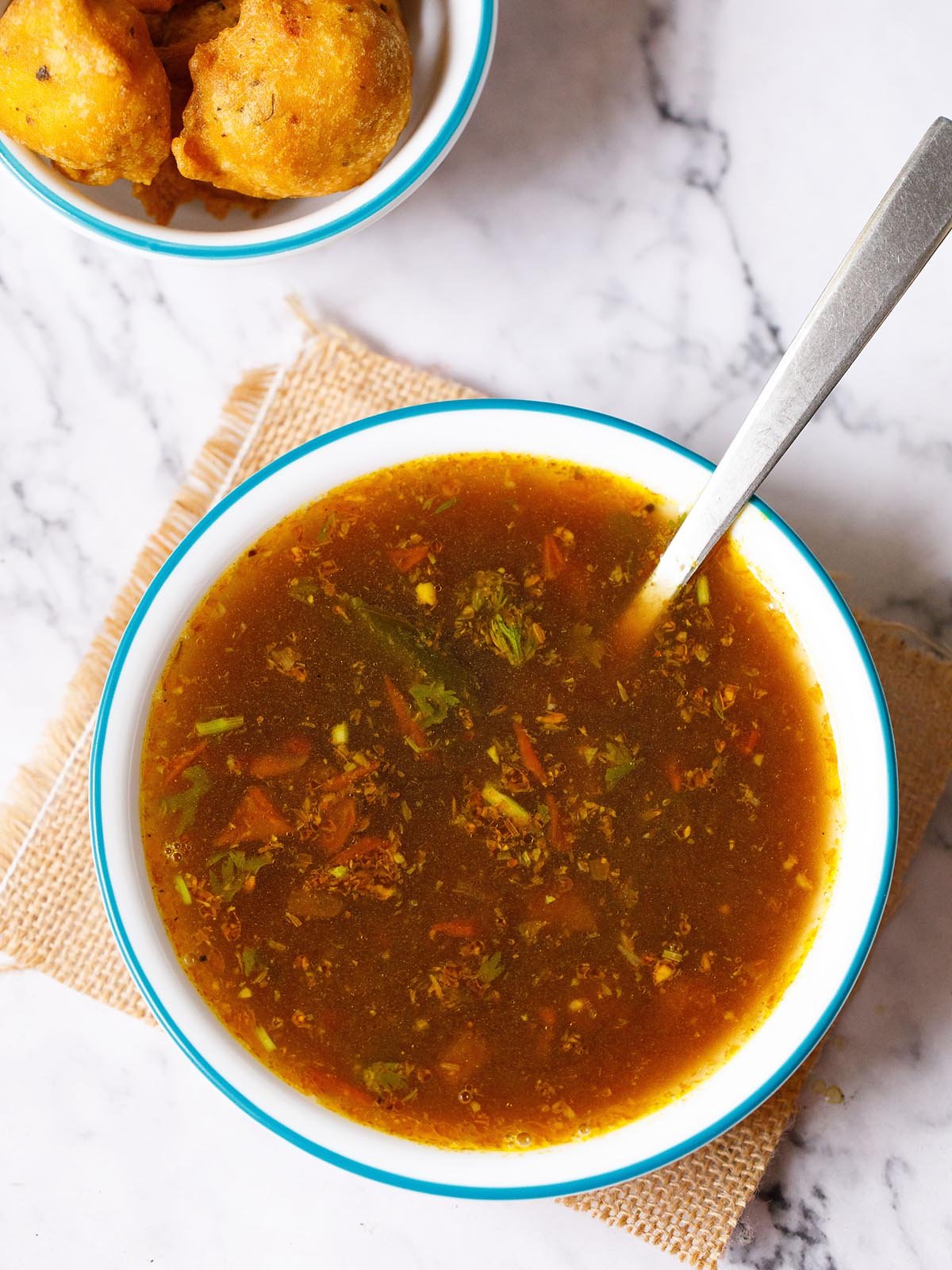
My rasam recipe is a basic simple South Indian rasam that can be had as a drink or served with rice. You do not need any Rasam Powder to make it nor you have to spend time cooking lentils.
This rasam recipe happens to be a family favorite and I make it similar to my Tomato Rasam recipe. The main difference between a tomato rasam and this rasam is the amount of tomatoes.
Obviously, in a tomato rasam, more tomatoes are added. But in a basic rasam, just one tomato is enough or you can skip it completely. The sour taste in a classic South Indian rasam recipe comes mainly from using tamarind and not tomatoes.
Though rasam is good to soothe a cold or cough you can still make it in any season. I make it pretty often, especially in the winters.
The spices and herbs that I add to my rasam recipe are cumin, mustard seeds, black pepper, garlic, curry leaves, coriander leaves, and tamarind that help in relieving the cold and also act as digestives. It is best to have it in chilly winters or when you are suffering from cough and cold.
Rasam can be had like a soup or as an appetizer drink. It can also be served with steamed rice along with a side vegetable dish and with sambar. You can also have idli or vada with rasam.
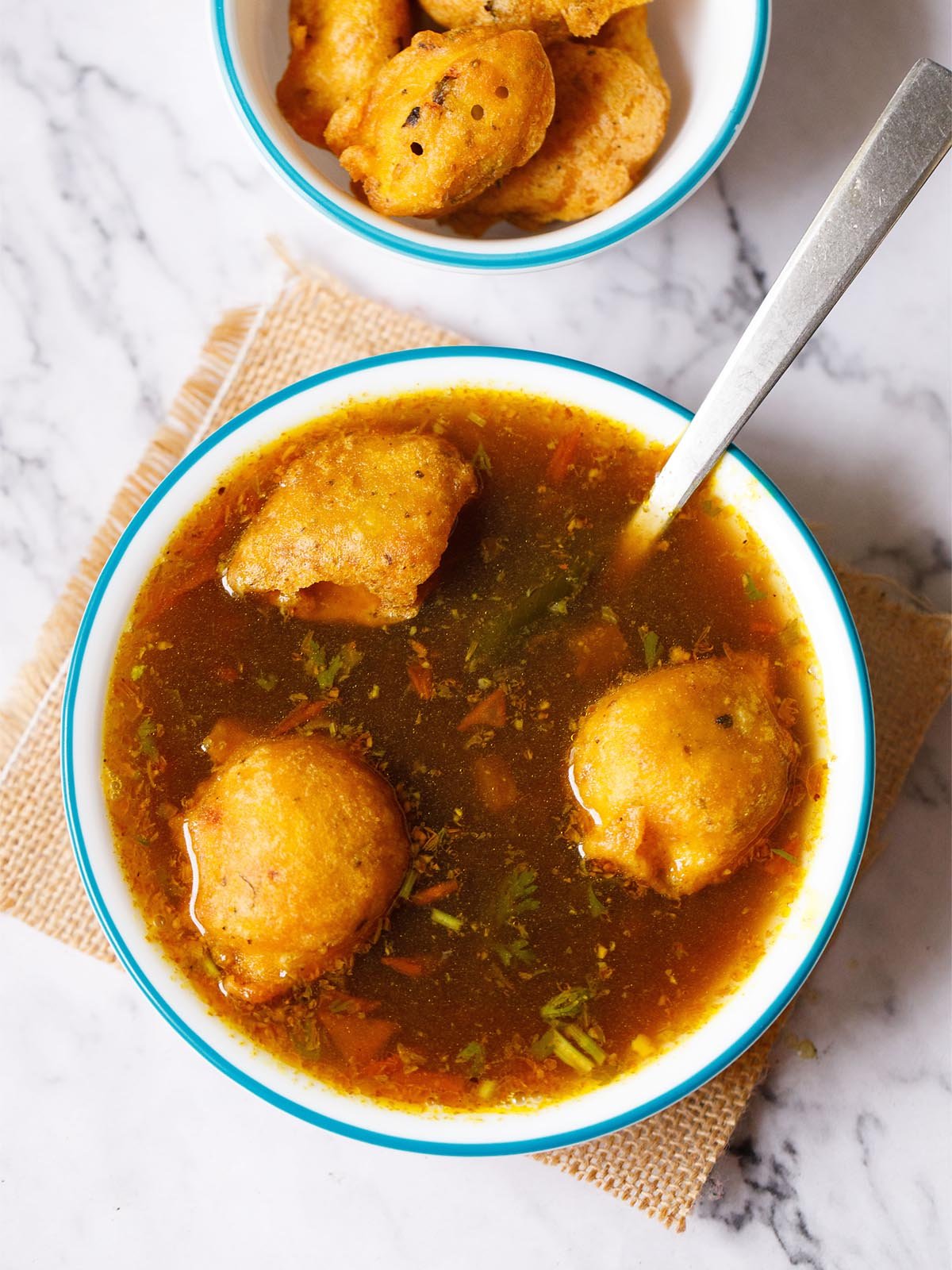
How to make Rasam Recipe
I have explained the making of the recipe in three parts. The first part includes making the tamarind water, the second part shows grinding the spices, and the third part details the method of making rasam.
Make Tamarind Water
1. Soak 1 lemon sized tamarind (approx 1 tablespoon tightly packed seedless tamarind) in ½ cup warm water for 20 to 30 mins.
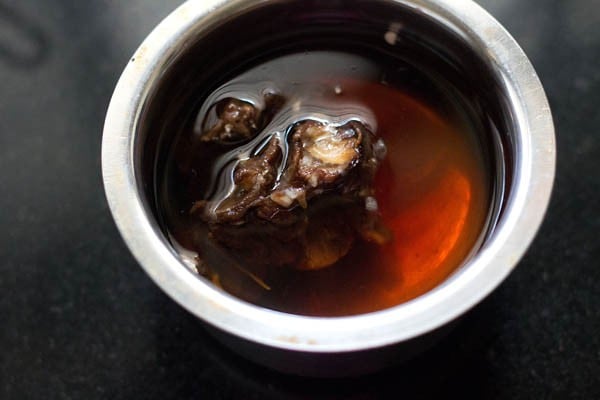
2. Later squeeze the soaked tamarind to a pulp. Strain and keep aside. In the below photo, the tamarind pulp is not strained.
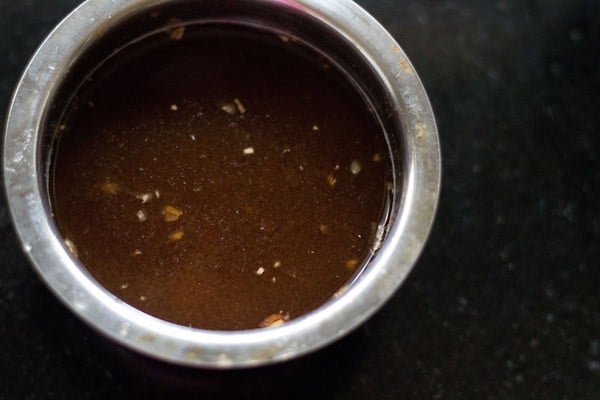
Grind Spices
3. In a dry grinder or coffee grinder, ground 3 teaspoon cumin seeds, 2 teaspoon whole black pepper, and 6 to 7 roughly chopped garlic (medium-sized) to a semi-fine consistency.
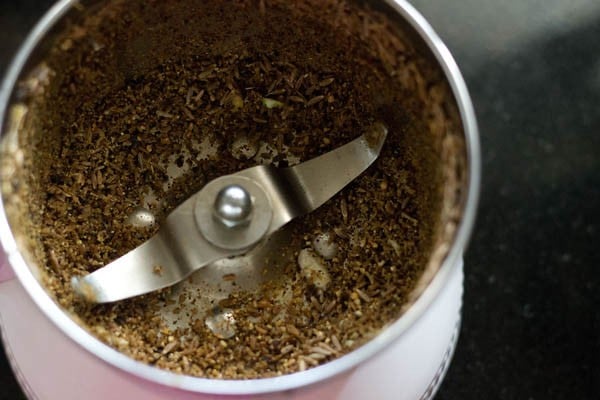
Make Rasam
4. Heat 2 tablespoons of oil and add 1 teaspoon mustard seeds. When the mustard seeds splutter, add two pinches of asafoetida, 2 to 3 dry red chilies, and 10 to 12 curry leaves. Be careful not to burn the spices.
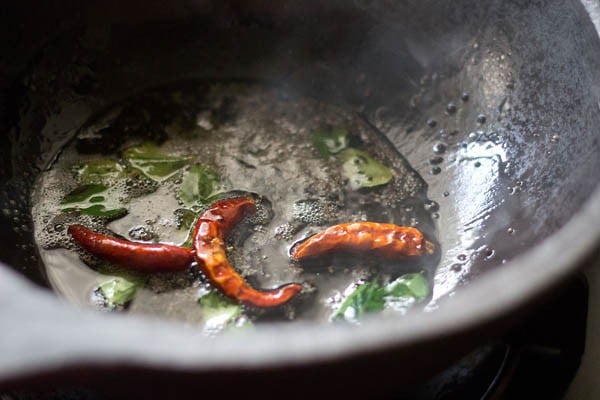
5. Add ½ cup chopped tomatoes. Sauté until the tomatoes soften.
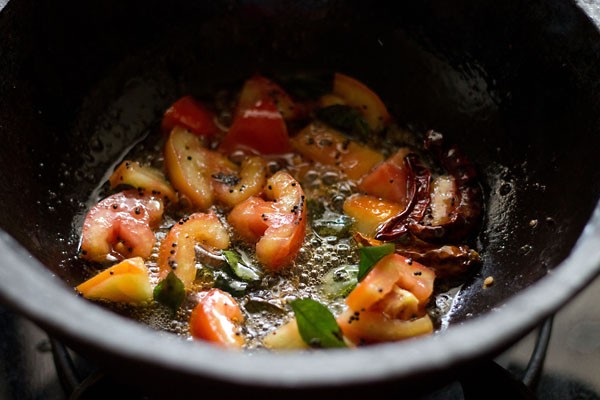
6. Then add the semi-coarsely ground cumin seeds, black pepper and garlic, and ½ teaspoon turmeric powder.
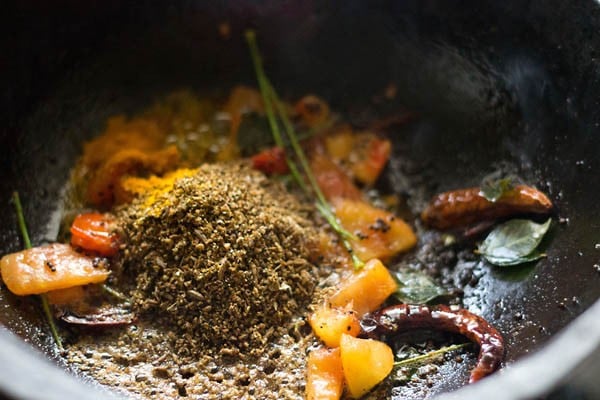
7. Mix well and add the strained tamarind pulp along with water and salt.
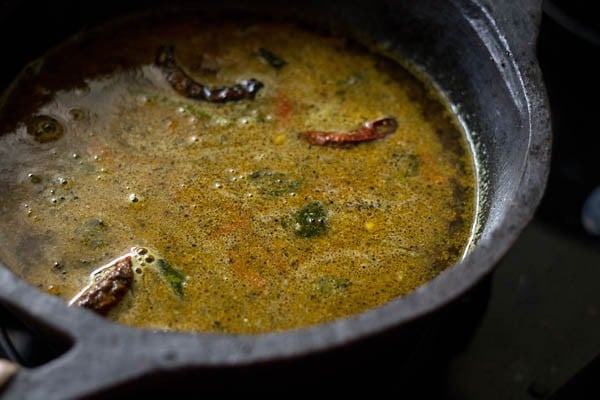
8. Let it come to a gentle simmer on a low heat. Do not boil, but let it slowly come to a point of gentle boil and then switch off the heat.
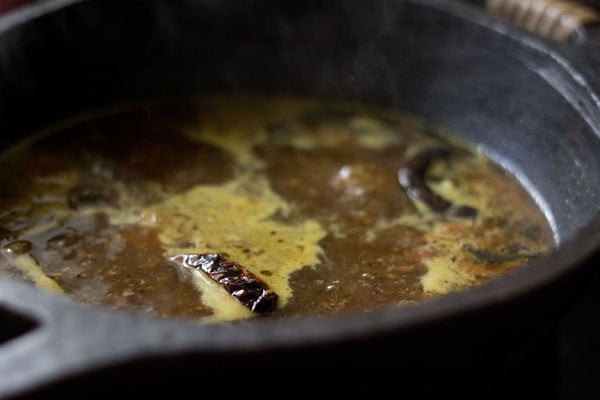
9. Turn off the heat and add 2 to 3 tablespoons of chopped coriander leaves.
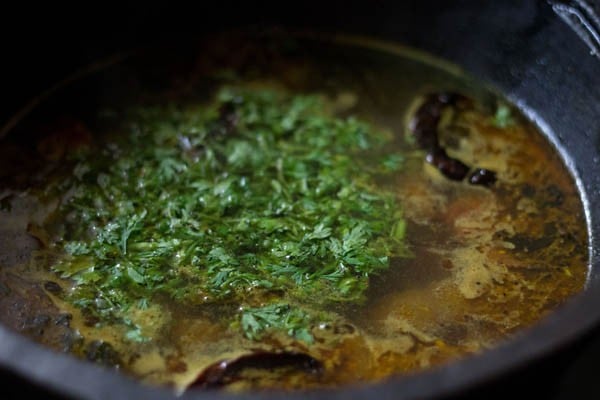
10. Stir and serve rasam hot with steamed rice or as a soup.
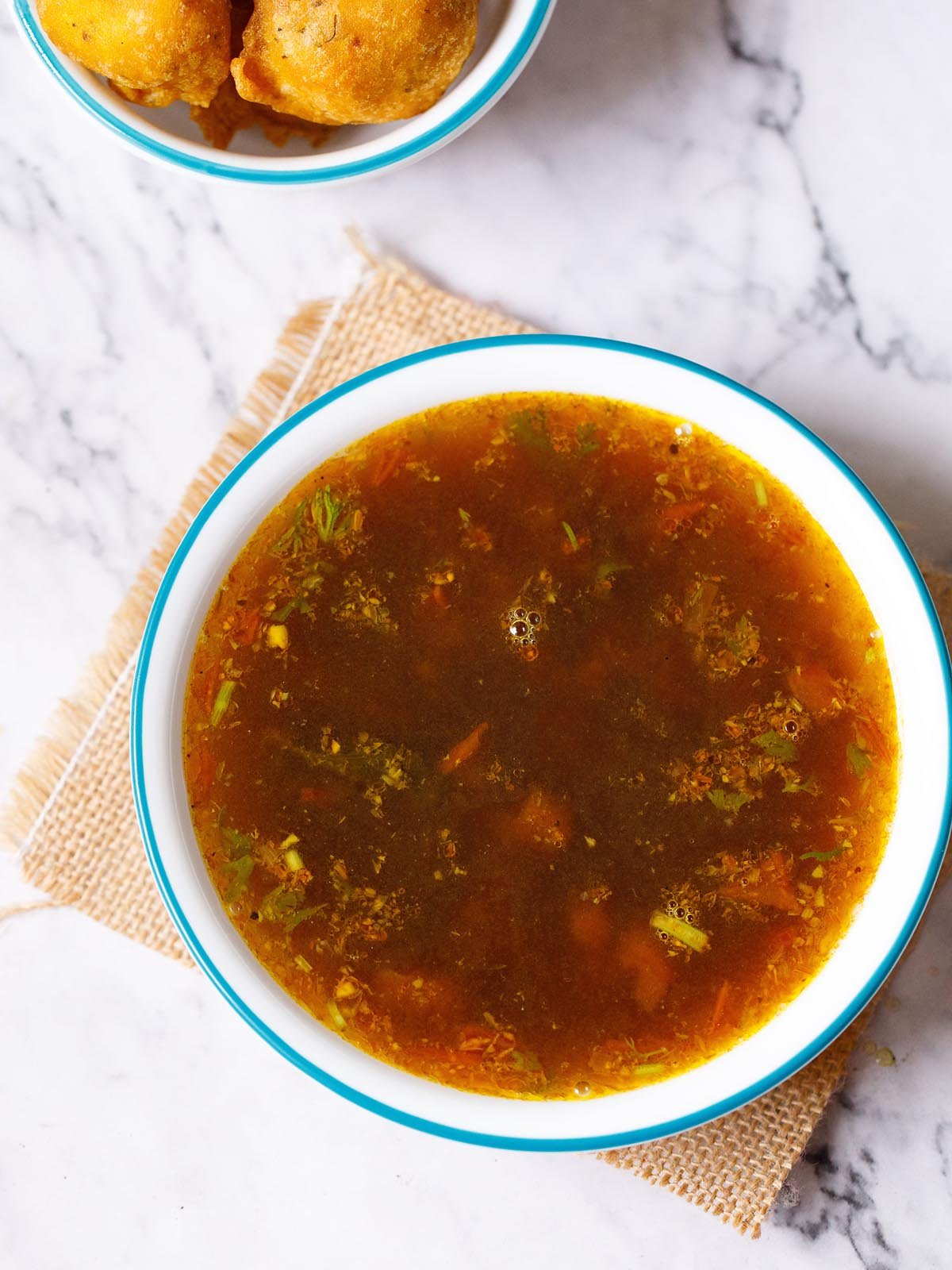
Serving Suggestions
The consistency of rasam is thin like a runny soup or stock. So you can drink it like soup. In South Indian meals, it is served with steamed rice, sambar, and a side vegetable dish.
You can also serve it with just plain steamed rice. I usually make it with rice and pair it with a side vegetable dish.
Sometimes I also make vada rasam or Idli rasam. Vada (fried urad lentil fritters) are amazingly good with this tangy and spiced rasam.
FAQs
Is there a substitute for tamarind?
The sourness of tamarind is different from the sour taste of lime or lemon. That being said, you could add lime or lemon juice. But add these juices when the rasam is finished simmering. You can add 1 to 2 tablespoons of lime or lemon juice depending on the sourness you prefer.
I have tamarind paste, so how much quantity I need to add?
Try adding 1 teaspoon tamarind paste first and mix it evenly with the warm water. If the sour taste is less, then add a bit more.
Can I skip garlic?
Yes, while you can make this recipe without garlic, I would recommend adding them as they give a really good flavor and taste.
Is rasam good for health?
Yes, it is healthy and immune-boosting. It is made with a mix of herbs and spices that not only help in relieving cold but also aid in digestion.
Can I freeze rasam?
Yes of course. Freeze the portion you need without adding coriander leaves. While serving gently warm or heat it and do not forget to sprinkle some coriander leaves.
How long can rasam be stored?
In the refrigerator, you can store it for 2 to 3 days. In the freezer, it stays good for a month.
Step by Step Photo Guide Above
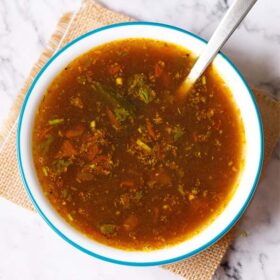
Rasam Recipe (Without Lentils)
Ingredients
Main ingredients
- 1 lemon sized tamarind – approx 1 tablespoon tightly packed seedless tamarind (imli)
- ½ cup warm or hot water – for soaking tamarind
- ½ cup chopped tomatoes or 1 medium-sized tomato
- 2 cups water
- 10 to 12 curry leaves
- 2 pinch asafoetida (hing)
- ½ teaspoon turmeric powder
- 1 teaspoon mustard seeds
- 2 to 3 dry red chilies – broken and deseeded
- 2 to 3 tablespoons chopped coriander leaves (cilantro)
- 2 tablespoons oil – gingelly oil (raw sesame oil) or any neutral oil
- salt as required
Spices to be ground
- 3 teaspoons cumin seeds
- 2 teaspoons black peppercorns
- 6 to 7 garlic cloves (medium-sized) – roughly chopped
Instructions
Preparation
- Soak the tamarind in warm water for 20 to 30 mins.
- Squeeze the pulp from the soaked tamarind. Strain and keep aside.
- In a dry grinder or coffee grinder, powder the cumin seeds, whole black pepper and garlic to a semi fine consistency.
Making rasam
- Heat oil in a pan. Crackle the mustard seeds first.
- Add the curry leaves, red chilies & asafoetida and fry for some seconds until the red chilies deepen their color.
- Fry on a low flame so that the spices don't burn.
- Than add the tomatoes and saute until the tomatoes soften.
- Then add the semi coarsely powdered cumin, black pepper and garlic along with turmeric powder.
- Stir and then add the tamarind pulp. Add water and stir well. Season with salt.
- Just let the entire rasam come to a gentle simmer uncovered on low heat.
- Then turn off the heat and add chopped coriander leaves.
- Serve rasam hot as a soup or with steamed rice.
Video
Notes
Tamarind substitutes:
- Lime or Lemon juice: Even though the sour taste of tamarind is different than lime or lemon, you can still add 1 to 2 tablespoons of lime or lemon juice. Add the lime or lemon juice when the rasam is finished simmering. You can vary the quantity depending on the sourness you prefer.
- Tamarind paste: Add 1 teaspoon tamarind paste and mix it evenly with the warm water. If the sour taste is less, then you can add a bit more.
Make ahead and storage:
- Freezing: In the freezer, rasam stays good for a month. Freeze the portion you want without adding coriander leaves. While serving gently warm or heat it and sprinkle some coriander leaves.
- Refrigeration: In the refrigerator, you can store rasam for 2 to 3 days.
Nutrition
Rasam recipe from the archives was first published on February 2014.

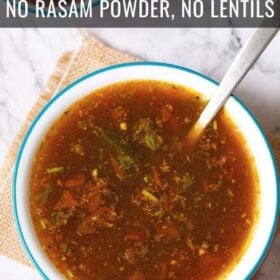
What else can I serve this rasam with, if not steamed rice?
Apart from steamed rice, you can enjoy rasam as a light soup on its own. It also pairs well with idli and vada, for a comforting meal.
I’ve been sick with covid and I live in Australia and my mum in Mauritius. She used to make us rasam whenever we were sick but I never really learnt how to make it.
Today is the worst I’ve been and she called me and said make rasam. I came across your recipe and with the very little energy and concentration i have at the moment, I tried it.
It is truly just what I needed. It is so perfectly balanced and the combination of sour and spices has been like food to my soul. Thank you.
Can’t wait to try your other recipes when I am well.
Thank you for this wonderful feedback. I am glad that you liked the recipe so much. I hope you have recovered by now. Take care.
Hello Sister.
.Can we use basil pesto or mint pesto in place of tamarind.
.Your brother.
Naresh.
Tamarind is added to make the rasam sour or tart. Basil or mint pesto won’t work. They will bring some herbaceous flavors but not make the rasam tart.
You can though experiment with the pesto and use fresh lemon juice to bring in sourness in the rasam.
Add the lemon juice towards the last step when you add coriander leaves. I hope this helps.
What a stunning recipe and so simple to make! As a bachelor living in Philippines, I was struggling so far to find a good rasam that gave me a taste of home. This fantastic rasam that too without any rasam powder (Difficult to get this in this country) was so delicious! My sincere gratitude to you for this lovely recipe. God Bless!
Great and thanks for sharing this super feedback on the rasam recipe. So glad!
Can I add kasuri methi instead of coriander leaves at the end?
No, the flavor will be very different.
Just learning to cook veg following your instructions. Thanks for sharing your experience with the recipes.
Thanks and nice to know. Thanks also for the rating on the recipe.
I’ll have to try the tomato one too, although I’ve always been a fan of tamarind!
Tried this today. Was able to finish in 10mins. Tasted great. Thanks a lot
Thank you for this feedback and the rating. Nice to know. Welcome.
this was an amazing starter for a special dinner I prepared !
This recipe is also so simple and quick…just had a huge bowl of this as an appetizer…was so heavenly,soothing and appetising…loved it…will try out other variations too.
thanks winnie. yes, do try other other rasam variations too. you will like them.
No extra exaggeration of the steps…very simple nd addaptible.thanks a ton..lots of luv
thank you soumya. hugs and welcome. thanks for the rating too.
Very easy nice procedure for preparation if rasam …nice guidence.thanks
Your website has become a go-to place for me, I have tried various recipes and I love how simple they are and they taste great! Keep up the good work! My food habits have become healthier because of your website!
that is nice to know. food is medicine and can correct many ailments. glad to read your comment. thanks and happy cooking.
It is tasty I always make rasam like this way instead of plain water can add vegs stock ex-drumstick leaves stock ,etc ,it will be more healthy. Thank you.
thanks samita for sharing the variation. yes that can be done.
Hi dassana!
I have tried many recipes of u and many has turned well. I have learnt a lot from ur blog. Thank you so much
I want to request from u to upload a recipe to make barfi from milk powder coz in my country we rarely can find khoya and its very expensive.
It would be a great help.
Thank you.
thanks and welcome fazma. i have noted down your recipe request and will try to add the recipe.
It was really awesome. Thank you for the receipe..
Hi.
First time I made Rasam following your recipe and it turned out great. Tasted exactly like what my mom and granny used to make.
Thanks
thanks for this lovely feedback on rasam recipe. glad to read it. welcome and happy cooking.
You can add cumin seeds while tadka (mustard seeds, cumin seeds and heeng and kadi patta).
thanks for the tip anuradha.
Thank u for this easy method.before I was adding coriander powder and little of red chilly powder .and tried this one today and tastes good and simple to drink hot ….
Welcome Dhanya. Glad to know that you liked this rasam recipe.
Hello there,
If we are using tamarind puree, how much do you put in. Thanks for this recipe. It looks great and i cant wait to try it.
Welcome Deavi. You can add 2 to 3 teaspoon. Add more if you want more sour taste. I never use tamarind puree. I soak tamarind in water and then squeeze it to get the pulp.
Absolute classic, easy to make and this is my first attempt…i am impressed .Effortless and delicious.
Thanks Diana for your positive feedback.
I am pregnant and wanted to have rasam since a long time. But due to nausea and weakness i didn’t bother to make it also didn’t have any rasam powder on my hands. Tried it for the first time.. and my my.. its so comforting. Will be making it more often. Thank you 🙂 ♡
thanks hira for sharing this. wish you all the best and take care.
Thank u for your awesome recipes
Welcome Kanya
Thanks … loved it
welcome.
Thank you
welcome vasu 🙂
Tasty to have
Easy to prepare
I loved it
Thanks for this recipe.
thanks for the positive feedback rajeev.
Looks simple and good, I shall try today thank u.
welcome and thankyou so much suganya 🙂
very nice and tasty receipe
thank you so much sangita 🙂
thankyou sangita 🙂
I have tried this recipe and it is absolutely spot on. Tasted just like the rasam my Anglo Indian granny used to make. Thanks for the pictures, they help to understand the recipe better.
thank you bernice. glad to know and am pleased that the rasam tasted like the one your granny used to make 🙂
Hi..I made this rasam recipe and supreb !!!..Thanks for the recipe
glad you liked the rasam recipe shasha 🙂 welcome and thankyou.
Thanks
Tried the rasam today.. came out excellent. . Superb..
thanks yasmin for this positive feedback.
I have tamarind paste. How can I substitute this for fresh tamarind? How much should I use?
try with 1 tsp first and if the sourness is not enough, then add 1/2 to 1 tsp more.
Hi please give me recipes of madrasi style ….. ( Brahmin / ayangar style ). podi – gun powder / tomato chutney / Onion chutney / garlic chutney & more easy sambar
I like the rasam recipe
& posting it step by step – picture format – is wonderful !!!
thanks. i have added the request in my notes and will try to update.
It was so easy awesome recipe. Thanks a lot that i made it today and got appreciation too 🙂 Thanks again madam.
welcome rabi. glad to know this.
Made rasam for the 1st time and wow ur reciepe was soooo easy and delicious.. thank you.
welcome shikha
This is a great recipe without rasam powder and I reckon it turned out better than the one I make with rasam powder. Rasam is my and hubby’s fav pouring dish and we both loved it!
Thanks M & J. Glad to know this.
I tried out this recipe a couple hours ago. And it turned out amazing, to say the least. It has the perfect blend of spice and sourness. Thank you!
welcome awwaas. glad to read your positive feedback.
Hi I would like to have your recipe so kindly send to my email
lalitha, i have added your email in the email subscription list. you will receive a confirmation email.
slight deviation from the topic..Good photography man 😀
thanks gokul
its a very good recepie.i aiso grind d coriander along wit other ingredients.
thanks dr hazra. good to know this.
its a good and easy
thanks pooja
Brillant….came very well 🙂
thanks peri
Tried out your recipe today! The rasam turned out to be great! Thanq!
welcome samuel
Tried rasam today and it came out really well.
Thanks for your recipe.
welcome and thanks vanadevan.
Thank you so much for the recipe . It was love at first sip of the rasam .
I just wanted to ask how much water should I put while making rasam ? I want to make my rasam like a soup .
rasam is thin and like a soup. 2 cups water mentioned in the recipe is enough to give a thin consistency. but if you add more, then the flavors and spiciness get diluted. so depending on your taste you can add a bit of more water.
Lovely !! I have bookmarked more than 10 recipes already.. That I do every time I visit your site Dassana..
thanks nupur.
Very interesting recipe.. have never fried the tomato in oil for rasam.
thanks preethi
Hi’ isn’t tamarind bad for your throat, when you are already suffering from cough ? cold is ok but doesnt it harm you when if u have cough . please clarify coz we in north india avoid sour things during cough.
thanks
its tamarind pulp that is used. the tamarind is soaked and then the pulp is extracted. its not like having tamarind directly. everything mixed together with the spices gives a relief to the throat.
Whenever i am asked to cook something new, i turn to ur site. Being new to cooking, i feel i would hve been a disaster in my in-laws kitchen if u were not here to help. Thanks for saving me. Can we make rasam without garlic?
thanks pushpa. you can make without garlic. but garlic gives a really good flavor and taste to the rasam.
Love love love rasam and paired with a papad it is so comforting. Lovely pics and tutorial.
Great taste! 🙂
Turned out very well and extremely easy to make…
Thanks for the recipe.
welcome ruchi. thanks for sharing positive feedback on rasam recipe.